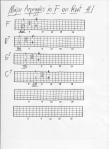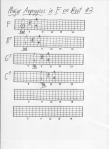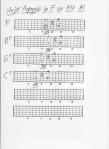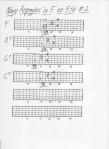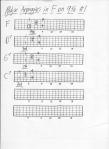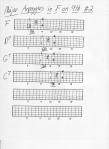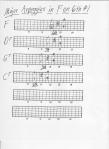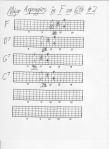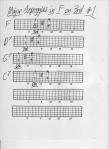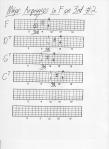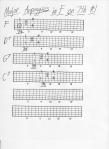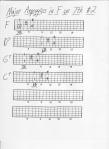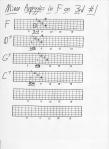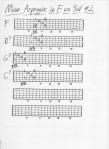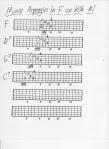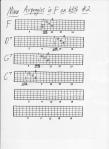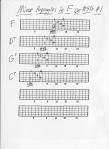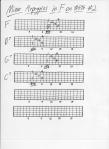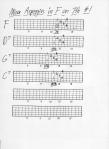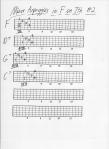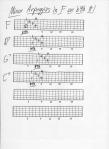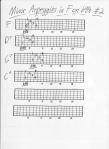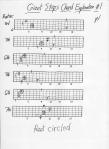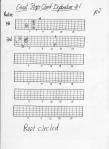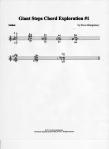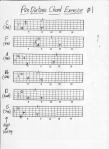CURRENTLY UNDER CONSTRUCTION
Pandiatonic Guitar?
ROAD MAP
- Overveiw
- How did I Come up With This Idea?
- List of Examples of Music With Pandiatonic Harmony
- Labels, Terms and Clarifications
- Pandiatonic Harmony in a Nutshell
- Arpeggios, Scales and Chords with Pandiatonic Harmony
- The Pandiatonic Arpeggio
- Fingerings for the Pandiatonic Arpeggio
- Applications for the Pandiatonic Arpeggio
- The Pandiatonic Scale
- Fingerings for the Pandiatonic Scale
- Applications for the Pandiatonic Scale
- The Pandiatonic Hexachord
- Pandiatonic Chords
- Chord Applications for Conventional Fingerings
- Chord Applications for Two Hand Fingerings
- Examples of Music with Pandiatonic Harmony
_____________________________________________________
Also be sure to visit https://twohandguitarvoicings.wordpress.com to learn more about Two Hand Guitar Voicings, including thumbnail fingerings, audio clips, originals and arrangements, and clear explainations.
_____________________________________________________
OVERVIEW
For years musicians have tinkered with ways to expand the harmonic pallete, devising systems, or else no system at all, in this pursuit. In the Classical world Stravinsky, Ives, Berg, Schoenberg, and a host of others, did amazing things to broaden musical vocabulary. In the Jazz world, the list is equally long, with names like John Coltrane and Miles Davis coming to the forefront.
While Polytonal, Twelve Tonal, and Atonal Schools of Thought have been more prevalent in the Classical world, “outside” and “free” playing have made substantial advances in Jazz over approximately the last 50 years. Often Jazz improvisations will slide in and out of these more “expanded” sorts of harmonies intuitively, implying a relation to other keys, without any systematic underpinning. Obviously, playing instinctively is not a problem, with numerous examples that attest to the skills of many gifted jazz soloists. Conversely, there have been jazz musicians who have supported the direction of their “outside” work more systematically.
What I hope to provide is a framework that will give input for writing and improvising, one that simplifies some of what has been labeled “outside,” which at times implies “outside” the realm of understanding, to be attained exclusively through impulse or inspiration. My focus will be primarily on Jazz Guitar and how what I will call Pandiatonic Harmony relates to it.
______________________________________________________
HOW DID I COME UP WITH THIS IDEA?
As I began to learn my scales and arpeggios in high school, I started to notice the inconsistencies with the Diatonic system. When I played arpeggios diatonically, I saw that there was a “glitch” in the pattern. The thirds progressed from major to minor, to major to minor, to minor to major to minor: C, E, G, B, D, F, A, C. The pattern of alternating major third to minor third was broken when D only went up a minor third to F, rather than continuing the pattern with a major third, landing on an F#. The same discrepancy occurred when A failed to go up a major third to C#, and instead only ascended a minor third, landing on C.
So I decided to try a more consistent pattern for constructing arpeggios; I would consistently alternate from major third to minor third. For a start, I got this: C, E, G, D, F#. I found that the flatted 5th provided by F# was a pleasant surprise, and obviously a familiar sound in the Jazz world. But the next departure from the key of C was a bit more alarming — a flatted 9th in a major key! C, E, G, B, D, F#, A, C#. This led me to the conclusion that the alternating major third to minor third construction, if used consistently, would promptly lead you right out of the key. It raised questions like; if F# (b5th) is an acceptable and sought after sound in jazz harmony, often used as an embellishment for major 7th chords, why isn’t C# (b9th) equally acceptable for major 7th chords? Especially since both pitches are derived from simply following the same Non-Diatonic, yet logically consistent, alternation of major and minor thirds: C, E, G, B, D, F#, A, C#. And what would happen to Diatonic harmony in the key of C if this logical progression was followed consistently beyond F# and C# to other points of “dissonance,” like G#, D# and A#?:
C, E, G, B, D, F#, A, C#, E, G#, B, D#, F#, A#
I also began to notice the presence of a Hexachord of stacked 5ths within this arpeggio:
C, E, G, B, D, F#, A, C#, E, G#, B, D#, F#, A#
These six Diatonically anchored pitches would become important in developing a sense of relative usefulness when applying the almost limitless choices provided by this sequence of notes, as well as a vocabulary of chord voicings that are Pandiatonically compatible.
As I continued to tinker with this idea of consistently alternating major and minor thirds, I noticed that I was hearing sounds similar to those of Wayne Shorter, Herbie Hancock, and many others whose “moderisms” had delighted but previously baffled me. I had obviously not found the Oracle of all Harmonic Wisdom, but at least a tool to help decode some of the incredible sounds of some of those incredible players. I found that continuing through this “Pandiatonic Arpeggio” (the term I began to use for the result of consistently following the pattern of major to minor third) would eventually make a complete cycle, ending where it began, running through all twelve Diatonic systems, a total of 24 notes, all 12 pitches, all 12 major and minor triads, from which would consequently come a redefining of the term “key.”
I found that the Pandiatonic Arpeggio may be seen as a harmonic backbone connecting all keys. It in turn creates a framework of stacked perfect 5ths, each composed of consistently alternating major and minor 3rds. I use the term Hexachord to label these 5ths within the Pandiatonic Arpeggio. The Hexachord, through the self-imposed limitation of only 6 notes, remains rooted in Diatonic harmony while simultaneously acting as the means to transcend it: C, G, D, A, E, B. Each note of the Hexachord acts as a portal, a point of departure, into what is often considered “outside.” This unity between Diatonic tradition and Pandiatonic expansion, provides an internal integrity and accounts for generating “outside” yet “familiar” music.
What does this imply as far as possibilities for chords? What about scales? Improvisation? Composition? The material below is for you to investigate, argue with, compromise with, and apply as you find useful.
______________________________________________________
LIST OF EXAMPLES OF MUSIC WITH PANDIATONIC HARMONY
How He Loves You and Me
Only the Very One at Heart
Unheard of
Star
Giant Steps Chord Explorations #1
Pandiatonic Chord Exercise #1
Pandiatonic Exercise
Heart Failure
Solitude
Faun
______________________________________________________
LABELS, TERMS AND CLARIFICATIONS
Pandiatonic: “Pan” means everything; “diatonic” means the harmonic system used in most Western music. According to Nicolas Slonimsky, who coined the term “pandiatonic” to describe what Stravinsky and Copland were up to musically, Pandiatonic means using the notes of the diatonic scale without conventional resolutions or chord progressions. I’ll be using the same term, but in a different way. The way I use it, “Pandiatonic” means the connecting of all keys through the backbone of a Pandiatonic Arpeggio constructed of alternating major and minor thirds, implying many of the conventions of Western music and at the same time going beyond them.
Pandiatonic Arpeggio: The Pandiatonic Arpeggio is the starting point from which the Pandiatonic Hexachord, the Pandiatonic Scale, and all subsequent chords, patterns, and improvisations stem.
Pandiatonic Hexachord: “Hexa” stands for 6; the way I’m using this term, it means a chord built by stacking 6 perfect 5ths, for example, C, G, D, A, E, B. This Hexachord exists within the Pandiatonic Arpeggio. A Hexachord may be applied to a tonal center or generated on a chord by chord basis. It also forms the basis of what I, arbitrarily, have set as the bounds for what is harmonically most useful.
Primary and Secondary Hexachords: “Primary” refers to the stacked 5ths of the Hexachord built on alternating major triads to minor triads; “secondary” refers to the stacked 5ths of the Hexachord built on alternating minor triads to major triads. Again, the assignment of these terms is purely arbitrary.
Octaves: The Pandiatonic “octave” is actually a #8th: C, D, E, F#, G, A, B, C#. Starting on one of the notes of the Secondary Hexachord produces an 8th, or octave: (C) E, F#, G, A, B, C#, D, E.
Chord Quality: In applying Pandiatonic Harmony to improvising and writing, I have made several compromises based on my personal opinion of what sounds “good” and is most often useful. The following are a few of these observations regarding chord quality.
(1) Pandiatonic Harmony seems most useful when applied to modifying major chords. This usefulness remains high for major chord applications all the way through the Hexachord (C, G, D, A, E, B).
(2) Pandiatonic Harmony “works” best on dominant 7th chords that are based on the 9th, 6th, 3rd, and 7th of the Hexachord.
(3) In Pandiatonic Harmony minor chords are the most problematic and, in my opinion, the chord quality that Pandiatonic harmony seems to have the least to offer, but this opinion is subject to change. In Pandiatonic Harmony, there is a major/minor merger due to the consistently alternating major and minor triads; any given major triad will be attached to a minor triad with the reverse also being true. This is not always the case in Diatonic harmony due to its built-in inconsistencies with triadic succession.
Intervals: I choose to call the 6th note of the Hexachord a 6th rather than a 13th because 13th, to me, implies a dominant 7th chord and detracts from the idea that the pitches are named according to common usage in chord labels for major chords.
The Big Picture? Interestingly, Pandiatonic harmony is analogous to Unified Theory. It is prescribed and bound by certain rules, such as with subatomic theory, but through those same rules, and paradoxically in opposition to the very rules driving the logic behind the system, it encompasses everything and enjoys the vantage point of the “Big Picture.” But that still leaves the arbitrary limitations which I have set on the diatonicly-limited perfect 5ths for the Hexachord (C, G, D, A, E, B), expressed intervalically (Root, 5th, 9th, 6th, 3rd, 7th), as an ironic embrace of apparent inconsistency. We should always give ear to the lessons of Ives and Berg in regard to the relative value of systems and the arrogance of inviolability over the harmonious compromise of judicially wrought self-limitation. The comprehensive order and consistency of Pandiatonic harmony, in contrast to the built-in inconsistency of Diatonic harmony, stands in a position to provide useful enhancements, greater choice and expanded horizons.
What is Pandiatonic Harmony? Pandiatonic Harmony is based on a moveable Hexachord of perfect 5ths. The Hexachord has been arbitrarily limited to six pitches and therefore remains Diatonic, i.e., C, G, D, A, E, B. It is “limited” in the sense that not going beyond a six-note Hexachord of stacked fifths is my subjective choice to bring order, usefulness and what I consider the more commonly used Pandiatonic chords, arpeggios and scales to the forefront. Obviously, this should not impede exploration and experimentation in what lies beyond the Hexachord. Pandiatonic harmony comes from this Hexachord and is applied primarily to major chords and dominant 7th chords, another subjective choice based on my observations of most common use.
What is a Pandiatonic Hexachord? What I mean by Pandiatonic Hexachord is another way to organize scales, arpeggios and chords that allows for options to Diatonic harmony and traditional theory. The Hexachord is composed of 6 stacked perfect 5ths (for example, C, G, D, A, E, B). It is from the Hexachord that the Pandiatonic Arpeggio, Pandiatonic Scale and Pandiatonic based chords are generated.
Why not just say “arpeggio” instead of “partial arpeggio”? I use the phrase “partial arpeggio” because there is only one Pandiatonic Arpeggio. This means that Pandiatonic-Compatible arpeggiations will always be only partial, unless the full 24-note, 12-key cycle is being played. This is why a root-centered, moveable, Hexachord is used to set practical limitations on the Pandiatonic Arpeggio and establish a point of reference.
What do you mean by “Pandiatonic-Compatible”? This phrase is used for arpeggios, scales, and chords that are based on the pattern of continuously alternating major and minor thirds.
What do you mean by “skipping”? Skipping is jumping from one point to another in the Pandiatonic Arpeggio, to interface sections of the Pandiatonic sequence, rather than to arpeggiate in direct succession.
For example: G, B, D#, F#, A#, C#, E, G#, A
implies a start in “G,” but then “skips” to “B” and “F#,” and finally “skips” to “A,” all of which are consistent with the G-based Hexachord.
What Good is a Structure for Playing Outside? Jazz players often speak of playing “outside.” “Outside,” however, is often so vaguely defined that it may mean anything from playing in other keys simultaneously (polytonal), playing “weird” or especially dissonant, to even playing randomly. In the final analysis, what “outside” can often end up meaning is following others known for their abilities to play “outside” (John Coltrane, McCoy Tyner, etc.) Although there is nothing wrong with having a master to emulate, Pandiatonic harmony provides a more systematic approach to playing “outside.”
Is Pandiatonic Harmony Better than Diatonic Harmony? The Diatonic system has been responsible for 100’s of years of good music, and much of our understanding of musical tension/resolution. Pandiatonic harmony is not a replacement of other harmonic systems, only a supplement. Just as Diatonic harmony is good and useful for certain types of sounds, so also is Pandiatonic harmony. Just as playing by ear, playing by instinct, is good and useful, so is informing the ear with the structure of Diatonic, Pandiatonic and other systems of harmony. All are simply sources of order, options, and input from which to deviate as musical needs dictate.
______________________________________________________
PANDIATONIC HARMONY IN A NUTSHELL
— Pandiatonic harmony provides a systematic way for playing “outside” and expands and supplements existing harmonic systems for improvisation and compositional use.
— Alternating major and minor thirds which create . . .
— The Pandiatonic Arpeggio which is . . .
— A 24-note arpeggio that encompasses and connects all 12 keys and all 12 diatonic systems which allows for . . .
— The Pandiatonic Scale which is . . .
— A 48-note scale composed of four-note continuously connecting mini-scales. Start on any pitch, such as (C), then ascend whole step/whole step/whole step then resolve up a half step to G:
C, D, E, F#, G
Then continue with the same pattern to A, B, C#, resolving up a half step to D:
C, D, E, F#, G, A, B, C#, D
then follow the same pattern to E, F#, G#, resolving up a half step to A:
C, D, E, F#, G, A, B, C#, D, E, F#, G#, A . . .
and so on, continuing through the remaining notes of the Pandiatonic Hexachord (C, G, D, A, E, B), or further through the complete cycle of the Pandiatonic Arpeggio, that encompasses and connects all 12 keys.
— A movable Pandiatonic Hexachord based on 6 stacked perfect 5ths exists within any given point of both the Pandiatonic Arpeggio and the Pandiatonic Scale. It provides a subjective limitation on the full cycle, 24 notes, of the Pandiatonic Arpeggio, and the full cycle, 48 notes, of the Pandiatonic Scale, and functions as something like a movable backbone for Pandiatonic Harmony.
______________________________________________________
ARPEGGIOS, SCALES AND CHORDS WITH PANDIATONIC HARMONY
These arpeggios, scales and chords are not meant to be used in a regimented way, always starting from a predetermined spot, but are better thought of as a continuous flow of interconnected notes, scales, arppegios and chords to be tapped in to from any point, and to skip from point to point in the Pandiatonic sequence, interweaving with other harmonic systems, such as Jazz Melodic Minor, Diatonic, etc., at will and as “the spirit leads.”
______________________________________________________
PANDIATONIC ARPEGGIOS
In Pandiatonic Harmony, from any given major triad that you are arpeggiating, you are only one note of the arpeggio away from being on a minor triad. For example, the major triad C, E, G, is ony one note away from becoming minor by starting on the E and building an E minor triad: E, G, B. This is not always the case with Diatonic arpeggios due to their built-in inconsistency. For example, the G, B, D major triad in the key of C (C, E, G, B, D, F, A, C) is not followed by the minor triad B, D, F#. In short, the Pandiatonic Arpeggio is built on consistently alternating major and minor triads, while Diatonic arpeggios are not.
______________________________________________________
The Pandiatonic Cycle (Arpeggio)
The Pandiatonic Cycle
______________________________________________________
FINGERINGS FOR PANDIATONIC ARPEGGIOS
Fingerings for “F Pandiatonic Arpeggio through the Hexachord”:
Listen to F Pandiatonic Arpeggio through the Hexachord
______________________________________________________
PANDIATONIC ARPEGGIO APPLICATIONS
Fingerings for Partial Pandiatonic Arpeggio Based on the 5ths of the Hexachord (Part 1):
Listen to Fingerings for Partial Pandiatonic Arp major and minor part 1
Fingerings for Partial Pandiatonic Arpeggio Based on the 5ths of the Hexachord (Part 2):
Listen to Fingerings for Partial Pandiatonic Arp major and minor part 2
______________________________________________________
Shapes for Partial Pandiatonic Arpeggio
______________________________________________________
Major Pandiatonic Partial Arpeggios in Bb
Listen to Pandiatonic Turnarounds in Bb (major arpeggios)
Pandiatonic Minor Partial Arpeggios in Bb
Pandiatonic Major and Minor Partial Arpeggios in Bb
Turnarounds for Pandiatonic Partial Arpeggios in C and G
______________________________________________________
Turnarounds for Major Pandiatonic Partial Arpeggios in F
Listen to Major Arp in F on Root #1 maj arp in F on root #1
Listen to Major Arp in F on Root #2 maj arp in F on root #2
Listen to Major Arp in F on 5th #1 maj arp in F on 5th #1
Listen to Major Arp in F on 5th #2 maj arp in F on 5th #2
Listen to Major Arp in F on 9th #1 maj arp in F on 9th #1
Listen to Major Arp in F on 9th #2 maj arp in F on 9th #2
Listen to Major Arp in F on 6th #1 maj arp in F on 6th #1
Listen to Major Arp in F on 6th #2 maj arp in F on 6th #2
Listen to Major Arp in F on 3rd #1 maj arp in F on 3rd #1
Listen to Major Arp in F on 3rd #2 maj arp in F on 3rd #2
Listen to Major Arp in F on 7th #1 maj arp in F on 7th #1
Listen to Major Arp in F on 7th #2 maj arp in F on 7th #2
______________________________________________________
Turnarounds for Minor Pandiatonic Partial Arpeggios in F
Listen to Minor Arp in F on 3rd #1 min arp in F on 3rd #1
Listen to Minor Arp in F on 3rd #2 min arp in F on 3rd #2
Listen to Minor Arp in F on b5th #1 min arp in F on b5th #1
Listen to Minor Arp in F on b5th #2 min arp in F on b5th #2
Listen to Minor Arp in F on #5th #1 min arp in F on #5th #1
Listen to Minor Arp in F on #5th #2 min arp in F on #5th #2
Listen to Minor Arp in F on 7th #1 min arp in F on 7th #1
Listen to Minor Arp in F on 7th #2 min arp in F on 7th #2
Listen to Minor Arp in F on b9th #1 min arp in F on b9th #1
Listen to Minor Arp in F on b9th #2 min arp in F on b9th #2
______________________________________________________
SKIPPING
Skipping is jumping from one point to another in the Pandiatonic Arpeggio, to interface sections of the Pandiatonic sequence, rather than to arpeggiate in direct succession. For example:
Example 1: Bb Pandiatonic: (up) Bb D F# A C# E F# (down) D B G
(The Bb Hexachord includes Bb, F, C, G, D, A, which is the same as saying Root, 5th, 9th, 6th, 3rd, and 7th. The above example of “skipping” moves through portions of the Bb Hexachord, starting with a partial Bb major triad, then skipping to a D major triad, an A major triad, a partial D major triad, and finally a G major triad. This could obviously by analyzed according to the presence of major 7th and minor arpeggios but, in either case, the continuous flow of alternating major and minor triads remains unbroken in relation to the staked 5ths of the Hexachord.)
Listen to Skipping in Bb Example 1
Example 2: Bb Pandiatonic: (down) G# E C# (up) F# (down) D B (up) C (down) A F D
(The Bb Hexachord includes Bb, F, C, G, D, A. The above example of “skipping” moves through portions of the Bb Hexachord.)
Example 3: G Pandiatonic: (up) G B D# F# A# (down) A G# E C# A (up) F#
(The G Hexachord includes G, D, A, E, B, F#. The above example of “skipping” moves through portions of the G Hexachord.)
Example 4: G Pandiatonic: (down) G F# D C# A# F# D B (up) E
(The G Hexachord includes G, D, A, E, B, F#. The above example of “skipping” moves through portions of the G Hexachord.)
______________________________________________________
THE PANDIATONIC SCALE
Just as with the Pandiatonic Arpeggio, it’s more accurate to think of scales in terms of one Pandiatonic Scale which is tapped into at whatever point is musically expedient.
______________________________________________________
The Pandiatonic Cycle (Scale)
The Pandiatonic Scale
_____________________________________________________
FINGERINGS FOR THE PANDIATONIC SCALE
Non-Stretch Fingerings
Stretch Fingerings
Slide Fingerings
F Pandiatonic Scale through the Hexachord
Fingerings for “F Pandiatonic Scale through the Hexachord”:
Listen to F Pandiatonic Scale through Hexachord
______________________________________________________
APPLICATIONS FOR THE PANDIATONIC SCALE
In the works.
______________________________________________________
THE PANDIATONIC HEXACHORD
The Hexachord is created by stacking six perfect 5ths, starting from any given note. The Hexachord provides a movable backbone, dependent upon what root or tonal center it is based on, from which arpeggios, scales and chords are fleshed out.
______________________________________________________
Pandiatonic Hexachords
Intervalic Relationships of Primary and Secondary Hexachords
Major and Minor Triads Through the Hexachord
The F Pandiatonic Hexachord
Fingerings for “The F Pandiatonic Hexachord”:
Listen to F Pandiatonic Hexachord
______________________________________________________
PANDIATONIC CHORDS
Pandiatonic chords are chords that are Pandiatonic-Compatible. This means that the pitches that comprise each of them fall within the parameters of a movable Hexachord. In other words, they are based on voicings whose roots are centered on the Root, 5th, 9th, 6th, 3rd, or 7th of the chord or tonal center, and whose pitches are derived from those available to the Hexachord.
______________________________________________________
FINGERINGS FOR PANDIATONIC CHORD VOICINGS
These are the five chord voicings that will be used for what follows, either for conventional fingerings or two hand fingerings.
G Pandiatonic Voicings #1
D Pandiatonic Voicings #2
______________________________________________________
CHORD APPLICATIONS FOR CONVENTIONAL FINGERINGS
Fingerings for Application of Pandiatonic Voicings 1
Listen to Application of Pandiatonic Voicings 1
______________________________________________________
Fingerings for Application of Pandiatonic Voicings 2
Listen to Application of Pandiatonic Voicings 2
______________________________________________________
Fingerings for Application of Pandiatonic Voicings 3
Listen to Application for Pandiatonic Voicings 3
______________________________________________________
Fingerings for Application of Pandiatonic Voicings 4
Listen to Applications of Pandiatonic Voicings 4
______________________________________________________
Fingerings for Application of Pandiatonic Voicings 5
Listen to Applications of Pandiatonic Voicings 5
______________________________________________________
Pandiatonic Voicings with the Root in the 5th or 6th String (Playable using Conventional Fingerings)
Pandiatonic Voicings with Root on 5th or 6th String page 1
Listen to Pandiatonic Voicings with Root on 5 or 6 String page 1
______________________________________________________
Pandiatonic Voicings with Root on 5th or 6th String page 2
Listen to Pandiatonic Voicings with Root on 5 or 6 String page 2
______________________________________________________
Pandiatonic Voicings with Root on 5th or 6th String page 3
Listen to Pandiatonic Voicings with Root on 5 or 6 String page 3
______________________________________________________
Pandiatonic Voicings with Root on 5th or 6th String page 4
Listen to Pandiatonic Voicings with Root on 5 or 6 String page 4
______________________________________________________
Pandiatonic Voicings with Root on 5th or 6th String page 5
Listen to Pandiatonic Voicings with Root on 5 or 6 String page 5
______________________________________________________
CHORD APPLICATIONS FOR TWO HAND FINGERINGS
The following voicings are applied through movable Hexachords (Root, 5th, 9th, 6th, 3rd, 7th) based on various roots or tonal centers. They include the 5 voicings used above in “Fingerings for Pandiatonic Chords.” The Root is indicated for voicings in which it is not, or cannot, be played. It is marked by placing an “R” on the appropriate fret. The interval of the top pitch of each voicing is given in relation to the root of the chord.
______________________________________________________
Pandiatonic Voicings for Two Hands (Type 1)
Fingerings Type 1, page 1
Listen to Pandiatonic Voicing for Two Hands (Type 1) page 1
______________________________________________________
Fingerings Type 1, page 2
Listen to Pandiatonic Voicings for Two Hands (Type 1) page 2
______________________________________________________
Fingerings Type 2, page 1
Listen to Pandiatonic Voicings for Two Hands (Type 2) page 1
______________________________________________________
Fingerings Type 2, page 2
Listen to Pan Voicing for Two Hands (Type 2) page 2
______________________________________________________
Fingerings Type 2, page 3
Listen to Pandiatonic Voicings for Two Hands (Type 2) page 3
______________________________________________________
Fingerings Type 2, page 4
Listen to Pandiatonic Voicings for Two Hands (Type 2) page 4
______________________________________________________
Fingerings Type 2, page 5
Listen to Pandiatonic Voicings for Two Hands (Type 2) page 5
______________________________________________________
Fingerings Type 2, page 6
Listen to Pandiatonic Voicings for Two Hand (Type 2) page 6
______________________________________________________
Fingerings Type 2, page 7
Listen to Pandiatonic Voicings for Two Hands (Type 2) page 7
______________________________________________________
Fingerings Type 2, page 8
Listen to Pandiatonic Voicings for Two Hands (Type 2) page 8
______________________________________________________
Fingerings Type 2, page 9
Listen to Pandiatonic Voicings for Two Hands (Type 2) page 9
______________________________________________________
Pandiatonic Voicings for Two Hands (Type 3)
Fingerings Type 3, page 1
Listen to Pandiatonic Voicings for Two Hands (Type 3) page 1
______________________________________________________
Fingerings Type 3, page 2
Listen to Pandiatonic Voicings for Two Hands (Type 3) page 2
______________________________________________________
Fingerings Type 3, page 3
Listen to Pandiatonic Voicings for Two Hands (Type 3) page 3
______________________________________________________
Fingerings Type 3, page 4
Listen to Pandiatonic Voicings for Two Hands (Type 3) page 4
______________________________________________________
Fingerings Type 3, page 5
Listen to Pandiatonic Voicings for Two Hands (Type 3) page 5
______________________________________________________
Fingerings Type 3, page 6
Listen to Pandiatonic Voicings for Two Hands (Type 3) page 6
______________________________________________________
Fingerings Type 3, page 7
Listen to Pandiatonic Voicings for Two Hands (Type 3) page 7
______________________________________________________
Fingerings Type 3, page 8
Listen to Pandiatonic Voicings for Two Hands (Type 3) page 8
______________________________________________________
Fingerings Type 3, page 9
Listen to Pandiatonic Voicings for Two Hands (Type 3) page 9
______________________________________________________
Pandiatonic Voicings for Two Hands (Type 4)
Fingerings Type 4, page 1
Listen to Pandiatonic Voicings for Two Hands (Type 4) page 1
______________________________________________________
Fingerings Type 4, page 2
Listen to Pandiatonic Voicings for Two Hands (Type 4) page 2
______________________________________________________
Fingerings Type 4, page 3
Listen to Pandiatonic Voicings for Two Hands (Type 4) page 3
______________________________________________________
Fingerings Type 4, page 4
Listen to Pandiatonic Voicings for Two Hands (Type 4) page 4
______________________________________________________
Fingerings Type 4, page 5
Listen to Pandiatonic Voicings for Two Hands (Type 4) page 5
______________________________________________________
Fingerings Type 4, page 6
Listen to Pandiatonic Voicings for Two Hands (Type 4) page 6
______________________________________________________
Fingerings Type 4, page 7
Listen to Pandiatonic Voicings for Two Hands (Type 4) page 7
______________________________________________________
Fingerings Type 4, page 8
Listen to Pandiatonic Voicings for Two Hands (Type 4) page 8
______________________________________________________
Pandiatonic Voicings for Two Hands (Type 5)
Fingerings Type 5, page 1
Listen to Pandiatonic Voicings for Two Hands (Type 5) page 1
______________________________________________________
Fingerings Type 5, page 2
Listen to Pandiatonic Voicings for Two Hands (Type 5) page 2
______________________________________________________
Fingerings Type 5, page 3
Listen to Pandiatonic Voicings for Two Hands (Type 5) page 3
______________________________________________________
Fingerings Type 5, page 4
Listen to Pandiatonic Voicings for Two Hands (Type 5) page 4
______________________________________________________
Fingerings Type 5, page 5
Listen to Pandiatonic Voicings for Two Hands (Type 5) page 5
______________________________________________________
Fingerings Type 5, page 6
Listen to Pandiatonic Voicings for Two Hands (Type 5) page 6
______________________________________________________
Fingerings Type 5, page 7
Listen to Pandiatonic Voicings for Two Hands (Type 5) page 7
______________________________________________________
Fingerings Type 5, page 8
Listen to Pandiatonic Voicings for Two Hands (Type 5) page 8
______________________________________________________
Fingerings Type 5, page 9
Listen to Pandiatonic Voicings for Two Hands (Type 5) page 9
______________________________________________________
Fingerings Type 5, page 10
Listen to Pandiatonic Voicings for Two Hands (Type 5) page 10
______________________________________________________
Fingerings Type 5, page 11
Listen to Pandiatonic Voicings for Two Hands (Type 5) page 11
______________________________________________________
Fingerings Type 5, page 12
Listen to Pandiatonic Voicings for Two Hands (Type 5) page 12
______________________________________________________
Fingerings Type 5, page 13
Listen to Pandiatonic Voicings for Two Hands (Type 5) page 13
______________________________________________________
EXAMPLES OF MUSIC WITH PANDIATONIC HARMONY
How He Loves You and Me
My arrangement of an Old Gospel tune. Listen to how the solo uses conventional harmonies until the end, where it branches off into Pandiatonic harmony.
Listen to How He Loves You and Me
______________________________________________________
Only the Very One at Heart
Based on the old standard Only the Very Young at Heart, made popular by Frank Sinatra. The chords and the melody owe some to Pandiatonic harmony.
Fingerings for “Only the Very One at Heart” by Steve Montgomery:
Listen to Only the Very One at Heart
______________________________________________________
Unheard of
A short improvisation. Listen to how the chords and soloing progress from conventional to Pandiatonic.
Listen to Unheard of
______________________________________________________
Star
This is a chord exercise based on the introductory “verse” of Stardust. Many of the chords are Pandiatonic-based.
Fingerings for “Star” by Steve Montgomery:
Here’s “Star” written out on the staff:
Listen to Star
______________________________________________________
GIANT STEPS CHORD EXPLORATION #1
This is a portion of “Giant Steps” by John Coltrane using Pandiatonic voicings for two hands.
Fingerings for “Giant Steps Expolaration #1” by Steve Montgomery:
Here’s “Giant Steps Chord Exploration #1” written out on the staff:
Listen to Giant Steps Exploration #1
______________________________________________________
PANDIATONIC CHORD EXERCISE #1
Fingerings for “Pandiatonic Chord Exercise #1” by Steve Montgomery
Listen to Pandiatonic Chord Exercise #1
______________________________________________________
PANDIATONIC EXERCISE
This is an example of harmonizing a Major 9th add #11 arpeggio (i.e., C, E, G, B, D, F#, A) through part of the Pandiatonic Arpeggio.
Listen to Pandiatonic Exercise
______________________________________________________
HEART FAILURE
This short original contains a mix of Pandiatonic Harmony and other sources of harmonic input.
Fingerings for “Heart Failure” by Steve Montgomery:
Here’s “Heart Failure” written out on the staff:
Listen to Heart Failure
______________________________________________________
SOLITUDE
I made this arrangement with Billie Holiday and her version in mind. I used just three voicings, two of which are Pandiatonic-Compatible, one that isn’t.
Fingerings for the bridge of “Solitude”:
Listen to Solitude (the bridge)
______________________________________________________
FAUN
This is my arrangement of “Prelude to the Afternoon of the Faun” by Claude Debussy. The ending uses one Pandiatonic-Compatible chord voicing in several different applications.
Fingerings for the ending of “Faun”:
Listen to Faun Ending
















